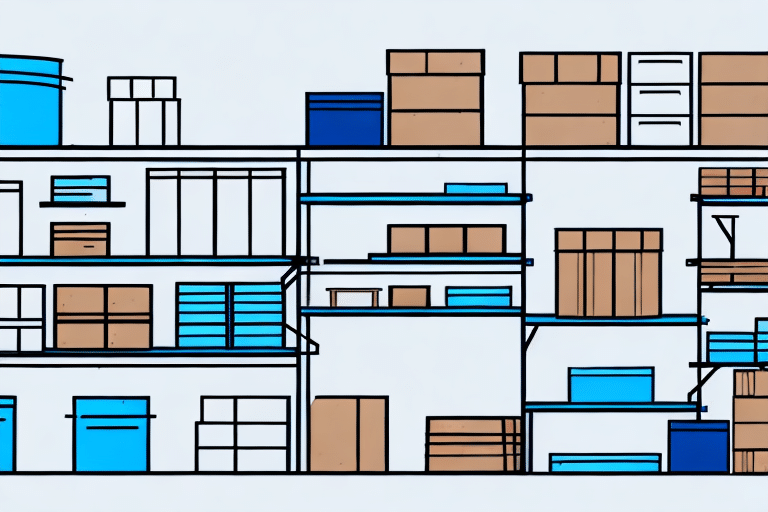Understanding Amazon's Long-Term Storage Fees
If you're selling products on Amazon, one of the hidden costs you'll need to keep a close eye on is the long-term storage fees. This article explores what these fees are, when they apply, and how to calculate them. We'll also discuss strategies for managing your inventory to avoid these fees and alternatives to using Amazon for long-term storage. By the end of this article, you'll have a better understanding of the impact of long-term storage fees on your bottom line and how to maximize your profits while minimizing costs on Amazon.
What Are Amazon's Long-Term Storage Fees?
Amazon charges long-term storage fees twice a year for any units that have been in their warehouse for more than 365 days. The fee is based on the volume of your inventory that has been in stock for over a year and is calculated as a flat rate per cubic foot. This fee is in addition to the monthly storage fees that Amazon charges for holding your products in their warehouse. Long-term storage fees can add up quickly, especially if you have slow-moving or seasonal products.
It's important to note that Amazon's long-term storage fees vary depending on the time of year. For example, if your inventory has been in their warehouse for over a year but the long-term storage fee assessment date falls between February 15th and August 15th, you'll be charged a lower fee than if the assessment date falls between August 16th and February 14th. This variation is designed to encourage sellers to move their slow-moving inventory during the peak holiday season.
How Amazon Calculates Long-Term Storage Fees
Amazon uses a specific formula to calculate long-term storage fees. They measure the volume of inventory that has been in their warehouse for more than 365 days and charge up to $6.90 per cubic foot. The fee is based on the duration your inventory has been stored—the longer it's there, the more you'll pay. If your inventory has been in their warehouse for over 730 days, you'll be charged double the standard rate.
Additionally, Amazon imposes a minimum long-term storage fee of $0.15 per unit for items that have been in their warehouse for over 365 days. This means that even if your inventory occupies less than a cubic foot, you'll still incur the minimum fee. However, Amazon offers a long-term storage fee waiver for items that have been in their warehouse for more than 365 days but have a sell-through rate of at least one unit in the past 90 days. This waiver helps sellers avoid paying the long-term storage fee for items that continue to sell well.
For the most accurate and up-to-date information on Amazon's storage fees, refer to the Amazon Seller Central.
When Do Amazon's Long-Term Storage Fees Apply?
Amazon's long-term storage fees are assessed twice a year, on February 15th and August 15th. The fees apply to any units that have been in Amazon's warehouse for more than 365 days as of those dates. To avoid these fees, it's crucial to monitor how long your inventory has been in stock and manage it efficiently. Amazon typically notifies sellers before charging long-term storage fees, but it is the seller's responsibility to actively manage their inventory.
These fees vary based on the size and weight of your products. Larger or heavier items will incur higher fees than smaller, lighter items. If your inventory isn't selling well, it may be beneficial to remove it from Amazon's warehouse to avoid these fees and free up space for more profitable products. Regular monitoring and informed decision-making can help you minimize long-term storage fees and maximize your profits on Amazon.
Strategies to Avoid Amazon's Long-Term Storage Fees
There are several strategies you can employ to avoid Amazon's long-term storage fees:
- Regular Inventory Review: Frequently assess your inventory levels to identify slow-moving or seasonal products. Removing these items promptly can prevent accumulating long-term storage fees.
- Optimize Pricing and Promotions: If a product isn't selling as quickly as expected, consider lowering its price or running promotions to boost demand.
- Use Amazon's FBA Inventory Removal Service: Remove products from Amazon's warehouse before the long-term storage fee assessment dates to avoid fees.
- Sell Through Alternative Channels: Utilize other platforms like eBay or your own e-commerce site to sell slow-moving or excess inventory.
- Implement Automated Pricing Tools: Use Amazon's automated pricing tools to adjust your prices based on competition and demand levels.
Planning ahead and using Amazon's storage fee calculator can help you estimate fees and make informed decisions about your storage strategy.
Alternatives to Amazon for Long-Term Storage
If you're seeking alternatives to Amazon for long-term storage, consider the following options:
- Third-Party Logistics (3PL) Providers: 3PL providers can offer storage and fulfillment services tailored to your needs. Some reputable 3PL services include ShipBob, ShipHero, and Fulfyld.
- Own Warehouse: If feasible, managing your own warehouse can give you more control over storage costs and inventory management.
- Alternative E-commerce Platforms: Selling through platforms like eBay, Shopify, or your own website allows you to manage storage independently of Amazon.
Evaluating the costs and benefits of each option will help you choose the best solution for your business needs.
Impact of Long-Term Storage Fees on Your Bottom Line
Long-term storage fees can significantly impact your profitability, particularly if you do not manage your inventory effectively. These fees can erode your margins and make it challenging to scale your business. For instance, as of 2023, the long-term storage fee can be up to $6.90 per cubic foot, which can add substantial costs for large or slow-moving inventories.
Proper inventory management and strategic decision-making are essential to mitigating these costs. By minimizing long-term storage fees, you can enhance your profit margins and allocate resources more effectively to grow your business.
Tips for Monitoring and Managing Your Inventory
To minimize long-term storage fees, implement these inventory management practices:
- Regular Monitoring: Keep track of inventory age and turnover rates using Amazon Seller Central analytics tools.
- Set Storage Limits: Establish maximum storage volumes for each product to prevent overstocking.
- Use FBA Inventory Reports: Leverage inventory health reports to identify products at risk of incurring long-term storage fees.
- Automate Price Adjustments: Utilize automated pricing strategies to remain competitive and encourage sales of slow-moving items.
- Plan Promotions Strategically: Schedule promotions to coincide with fee assessment dates to clear out inventory in time.
Implementing these practices will help you maintain optimal inventory levels and reduce the likelihood of incurring long-term storage fees.
Other Costs to Consider When Selling on Amazon
In addition to long-term storage fees, several other costs can affect your profitability when selling on Amazon:
- Referral Fees: A percentage of each sale, varying by category.
- Fulfillment Fees: Costs associated with Amazon's FBA service, including picking, packing, and shipping.
- Advertising Fees: Expenses for Amazon's advertising services to increase product visibility.
- Shipping Costs: Costs for shipping products to Amazon's fulfillment centers or to customers through FBM.
It's crucial to factor these costs into your pricing strategy to ensure that you're maintaining profitability on each sale.
Maximizing Profits While Minimizing Costs on Amazon
To maximize your profits while minimizing costs on Amazon, consider the following strategies:
- Optimize Pricing: Implement competitive pricing strategies to attract more buyers without sacrificing margins.
- Enhance Product Listings: Optimize your product titles, descriptions, and keywords to improve search visibility and conversion rates.
- Leverage Amazon Advertising: Use targeted advertising campaigns to increase product visibility and sales.
- Efficient Inventory Management: Regularly assess and adjust your inventory levels to prevent overstocking and minimize storage fees.
- Utilize Fulfillment Alternatives: Consider using Fulfillment by Merchant (FBM) or other fulfillment options to reduce reliance on FBA and associated fees.
By implementing these strategies, you can enhance your profitability on Amazon, ensuring that your business remains competitive and financially healthy.
Conclusion: Managing Amazon's Long-Term Storage Fees for Profitability
Understanding and managing Amazon's long-term storage fees is essential for maintaining a profitable business on the platform. By comprehending how these fees are calculated, knowing when they apply, and implementing effective inventory management strategies, you can minimize their impact on your bottom line. Additionally, exploring alternatives for long-term storage can provide greater flexibility and cost savings. Utilize the tips and strategies outlined in this article to effectively manage your inventory, reduce costs, and maximize your profits as an Amazon seller. With proactive management and strategic planning, you can thrive in the competitive Amazon marketplace.




















